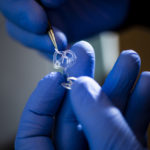About Leila Deravi
The Biomaterials Design Group at Northeastern University works at the interface of bio-analytical chemistry, materials science, and design. We investigate fundamental mechanisms behind systems in biology and use our understanding to better inform the design new classes of protein-based biomaterials that may interface with or enhance the performance of humans. Thus, a key aspect of our research is developing strategies to build the structure dependent function of biomolecules into macromolecular materials. A summary of our ongoing projects to support this goal are described here:
- Fibrillogenesis. We investigate how natural and synthetic polymers come together and assemble into a fibrous network. Inspired by how cells build their extracellular matrix, we develop experimental strategies to induce fibrillogenesis across multiple spatial scales (nano- to centi- meter). Based on the structure and composition of the self-assembling protein or polymer network of interest, we explore applications that can range from tissue engineering to textile design.
- Bionics. Engineering at the biotic-abiotic interface by modifying the natural function and composition of the extracellular matrix will not only provide alternative substrates for wearable or implantable electronics that are flexible but also introduce new materials that are capable of chemically coupling to tissues and organs in vivo. We adapt additive manufacturing techniques to build customizable protein based materials. We are developing chemistries that will enable us to re-purpose protein binding domains towards these applications.
- Bio-optics. Cephalopods such as squid, octopus, and cuttlefish are capable of rapid (~100 msec) and adaptive changes in coloration by varying the local distribution of dermal pigments and proteins to reflect, absorb, and transmit light. We study the molecular mechanism that regulates this process, where we focus specifically on the role of their pigment-containing nanoparticles in absorbing and scattering light across the ultraviolet through short-wave infrared regions. We build materials inspired by the cephalopods designed to enhance these characteristics for wearable applications. We also dedicate time to optimizing and innovating methods to harness the pigments and proteins found in cephalopod tissue. More information specific to our squid dissections can be found here.
The Biomaterials Design Group at Northeastern University works at the interface of bio-analytical chemistry, materials science, and design. We investigate fundamental mechanisms behind systems in biology and use our understanding to better inform the design new classes of protein-based biomaterials that may interface with or enhance the performance of humans.
The Institute develops imaging tools to highlight chemical processes – enabling clinicians to better diagnose and treat disease.













